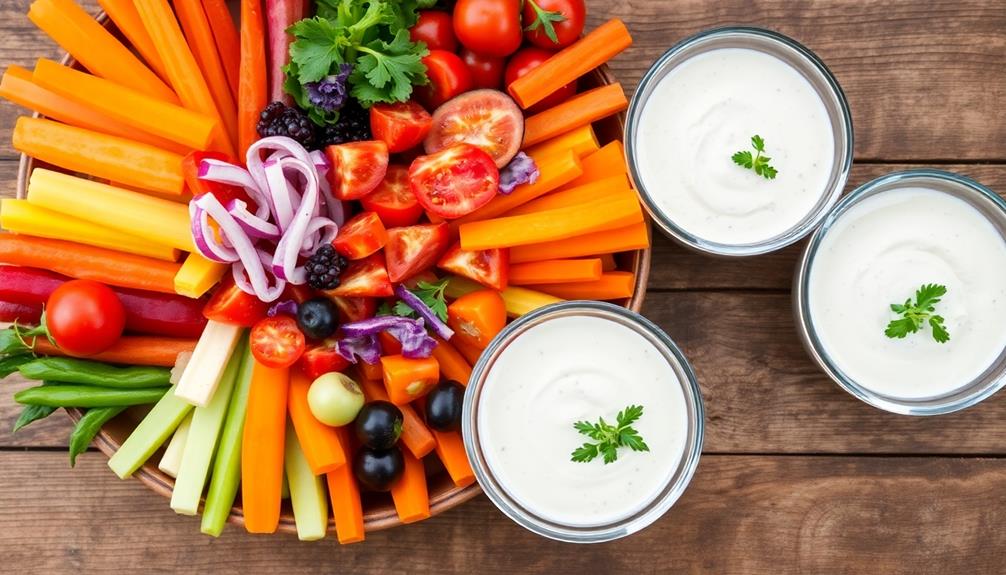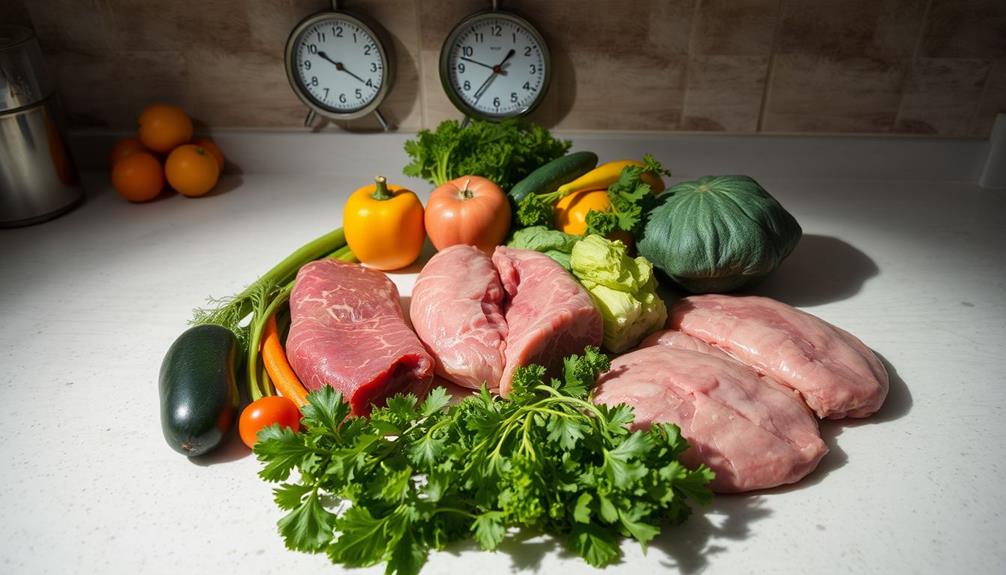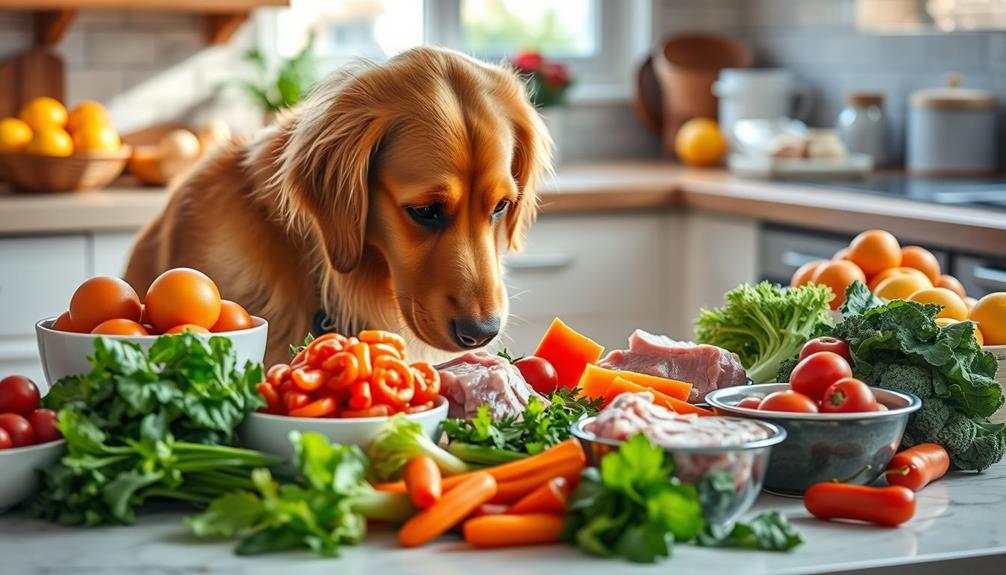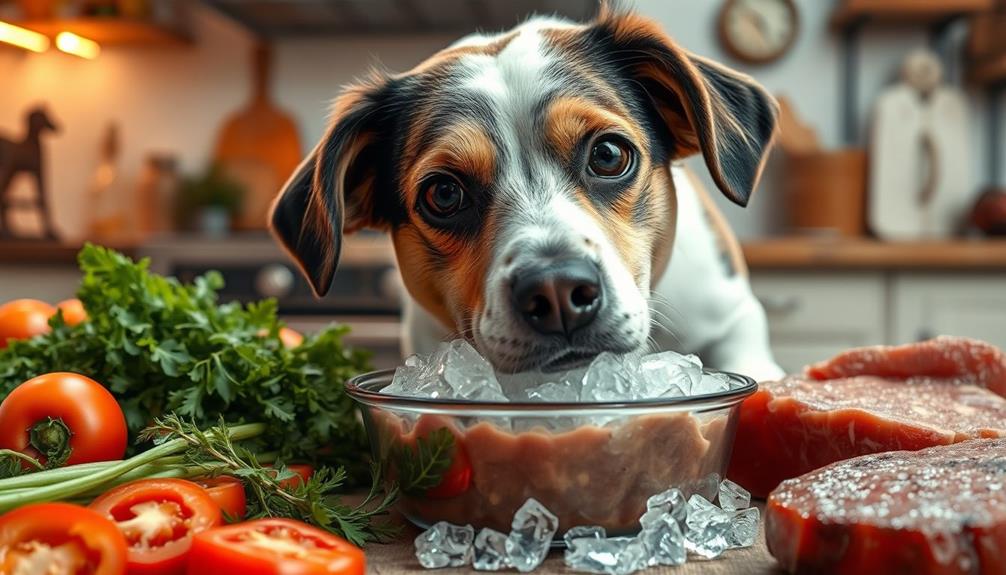Raw food can indeed cause seizures in dogs if the diet isn't properly balanced. High levels of glutamate in certain meats and fish may trigger seizure activity in sensitive dogs. Nutritional deficiencies, like a lack of omega-3 fatty acids or imbalanced calcium and phosphorus, can further increase the risk. It's vital to monitor ingredient quality and guarantee your dog's diet meets all nutritional needs. Always consult with a vet to create a safe and suitable raw food plan. By staying informed about potential triggers, you can help maintain your dog's overall health and well-being. There's much more essential information ahead.
Key Takeaways
- Raw diets can contain high-glutamate ingredients that may trigger seizures in susceptible dogs, warranting careful selection of food sources.
- Nutritional imbalances in poorly formulated raw diets can lead to deficiencies, increasing the risk of seizures.
- Omega-3 fatty acids are essential; their deficiency in raw diets may contribute to increased seizure frequency and inflammation.
- Contaminants and toxins in raw ingredients can pose serious health risks, including the potential for seizures.
- Consulting a veterinary nutritionist is crucial for designing a balanced raw diet that minimizes seizure risks in dogs.
Signs of Seizures in Dogs
When a dog has a seizure, it can be alarming for any pet owner. Recognizing the signs of seizures is fundamental for ensuring your furry friend's safety.
During a seizure, you might notice sudden loss of balance or an immediate fall. Your dog could exhibit erratic jerking or twitching movements, which can be distressing to witness. Some dogs may run or pace in circles, display stiff muscles, and seem confused during or after the episode.
It's significant to mention that stress or certain dietary changes, such as introducing a new diet or raw food, can also contribute to seizures in some dogs.
Uncontrolled urination, defecation, and excessive drooling are also common behaviors during seizures in dogs. You might see muscle twitching or paddling motions with their legs, and sometimes they may lose consciousness, leading to foaming at the mouth.
It's critical to time the duration of any seizure, especially if it lasts longer than a few minutes or if multiple seizures occur in a short period. This information is essential for your veterinarian when discussing possible idiopathic epilepsy or other underlying issues.
Being aware of these signs of seizures can help you respond quickly and effectively, ensuring your dog gets the care they need as soon as possible.
Common Causes of Seizures

Seizures in dogs can stem from a range of causes, making it vital for pet owners to understand the potential triggers. One of the most common causes of seizures is idiopathic epilepsy, which has no identifiable medical reason and is frequently seen in certain dog breeds.
If you have dogs with epilepsy, it's important to recognize that genetic predisposition can play a significant role in their likelihood of experiencing seizures. Additionally, certain dietary factors, such as imbalanced nutrition or exposure to harmful substances in food, can contribute to seizure activity; consequently, it's important to be mindful of what you feed your pet, including any cold medications that may inadvertently affect their health.
Environmental toxins also pose a risk. Ingesting poisons like chocolate, alcohol, or antifreeze can provoke seizures, as can exposure to harmful plants and chemicals.
Additionally, medication side effects and metabolic disorders, including low blood sugar levels, are known triggers.
Don't overlook underlying medical issues, either. Conditions such as brain tumors or infections might manifest as seizures, signaling a serious health concern.
Always consult your veterinarian if your dog experiences seizures, especially if they've existing health problems. Understanding these common causes of seizures will help you take proactive measures to safeguard your dog's health and well-being.
Dietary Factors and Seizures
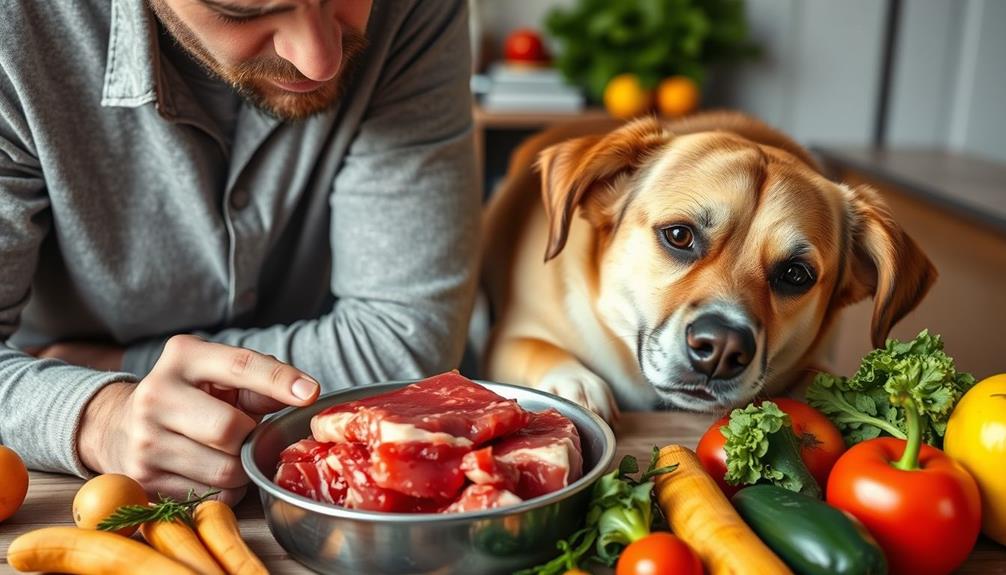
When considering your dog's diet, it's important to recognize how certain foods can affect seizure activity.
High-glutamate sources and nutritional imbalances might trigger seizures in susceptible dogs.
For instance, certain health benefits of plant-based diets can influence overall wellness.
High-Glutamate Food Sources
Understanding the impact of high-glutamate foods on your dog's health is vital, especially if they're prone to seizures. Proper diet and nutrition are fundamental for maintaining overall health in pets, and avoiding certain foods can be part of that strategy.
High-glutamate foods like grains (wheat, barley, oats), dairy (especially from cow's milk), legumes (soy, beans), and peanuts can potentially aggravate seizure tendencies in dogs. Elevated glutamate levels in their diet may increase neuronal excitability, which can trigger seizures in susceptible dogs.
It's important to monitor and limit the intake of these high-glutamate foods in your dog's diet. By doing so, you can manage their seizure disorders more effectively.
Environmental factors also play a role; exposure to chemicals and stressful situations can interact with dietary glutamate and further heighten seizure risk. Routine health checks for signs of illness are recommended to guarantee your dog's well-being.
Transitioning to a fresh, natural diet that minimizes high-glutamate ingredients may contribute to better seizure control and overall health in dogs.
If your dog has a history of seizures, consider consulting with your veterinarian to create a balanced diet plan that avoids these problematic foods. By making informed dietary choices, you can help reduce the chance of dogs experiencing seizures and improve their quality of life.
Nutritional Imbalances and Seizures
How can nutritional imbalances in your dog's raw food diet contribute to seizures? When you don't provide balanced nutrition, your dog might miss out on essential nutrients, leading to improper brain function that can trigger seizures in susceptible pups.
A deficiency in omega-3 fatty acids is particularly concerning, as it can contribute to inflammation and oxidative stress in the brain, potentially worsening seizure frequency and severity. Additionally, many pet owners may overlook the significance of ultimate hamster care when considering dietary choices for their pets.
High-glutamate foods often found in certain raw diets can increase seizure activity, so you'll need to be careful with your ingredient choices.
Vitamins like E and B complex are essential for neuronal protection; inadequate levels could mean your dog isn't getting the support it needs to reduce seizure occurrences.
When introducing a raw diet, it's important to do so gradually. Sudden dietary changes can lead to gastrointestinal distress, which may inadvertently trigger seizures in sensitive dogs.
Raw Diet Considerations
Nutritional imbalances in a dog's raw food diet can directly influence seizure activity. When you choose a raw diet for your dog, it's essential to take into account how certain ingredients might affect their brain health, especially if they've a predisposition to epilepsy.
For instance, the use of certain essential oils, such as eucalyptus oil, can be beneficial for overall health, but should be approached with caution in dogs. Here are some key factors to keep in mind:
- Glutamate levels: Some meats and fish in raw diets can be high in glutamate, which may trigger seizures in sensitive dogs.
- Omega-6 fatty acids: Ingredients rich in omega-6 can promote inflammation in the brain, potentially increasing seizure frequency.
- Nutrient deficiencies: A raw diet lacking in essential vitamins, such as E and B complex, can lead to deficiencies that negatively impact your dog's neurological health.
While the absence of synthetic preservatives in raw diets can be beneficial, you must verify that the diet is balanced and free from harmful toxins.
Always monitor the source and quality of the raw ingredients, as contaminants or imbalances could lead to serious health issues, including seizures, in susceptible dogs.
Prioritizing a well-rounded raw diet can help maintain your dog's health and minimize seizure risks.
Harmful Ingredients to Avoid

When crafting a raw food diet for your dog, it's important to steer clear of certain harmful ingredients that could trigger seizures. High-glutamate foods like grains—such as wheat, barley, and oats—and dairy products, especially cow's milk, can exacerbate seizure tendencies. These are significant ingredients to avoid in your dog food.
Individuals with certain conditions, including those related to emotional dysregulation, may also experience heightened sensitivity to specific dietary components, making it critical to tailor food choices carefully to avoid adverse effects emotional dysregulation issues.
Additionally, peanuts and legumes, often used as treats, are also high in glutamate and may contribute to seizure activity. You should prioritize fresh, natural ingredients free from toxins to safeguard your dog's health.
Chemical additives and preservatives, like BHA and artificial colors, have been linked to increased seizure risks, so avoiding these foods is significant.
Lastly, be mindful of environmental toxins, as exposure can also trigger a seizure in susceptible dogs. Maintaining a balanced diet with low-glutamate options while eliminating harmful ingredients is essential for dogs prone to seizures.
Raw Food and Nutritional Imbalance
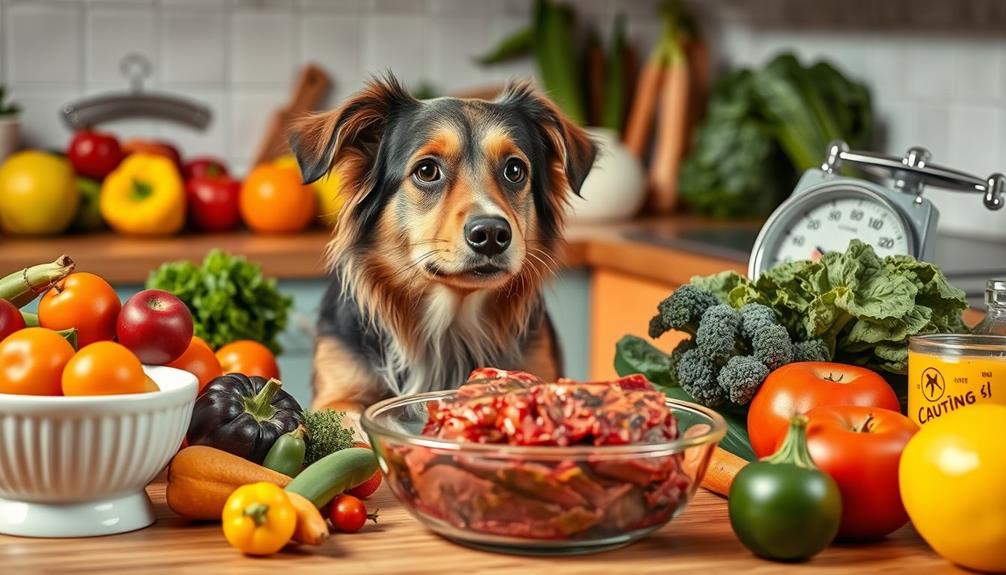
When you consider a raw food diet for your dog, it's vital to guarantee it's properly balanced. Nutritional deficiencies can arise if essential vitamins and minerals are missing, potentially impacting your dog's neurological health.
To avoid these issues, it's important to consult with a veterinary nutritionist who can help design a suitable diet plan that meets all your dog's nutritional needs.
Additionally, imbalanced ingredient ratios, like inadequate calcium and phosphorus, can lead to serious health issues, including an increased risk of seizures.
financial considerations for elderly care
Nutritional Deficiencies Risks
Many dog owners are unaware that poorly formulated raw food diets can lead to serious nutritional imbalances. These imbalances can result in notable nutritional deficiencies that harm your dog's neurological health.
For instance, a lack of omega-3 fatty acids, which are often missing in raw meat diets, can increase seizure frequency due to their vital role in maintaining healthy brain cell membranes. Additionally, just like in human development where environmental interactions shape individual growth, the nutritional environment provided to dogs can greatly influence their health outcomes.
This highlights the importance of understanding key domains of development in psychology as they can relate to overall health and well-being, including developmental milestones assessed.
Here are some key nutritional risks to keep in mind:
- Insufficient calcium and phosphorus balance can lead to secondary hyperparathyroidism, negatively affecting brain function.
- A deficiency in vitamin E may cause oxidative stress, leading to neuronal damage and a higher risk of seizures.
- Inadequate protein sources can result in amino acid deficiencies, especially in glycine and taurine, which are essential for neurotransmitter function.
Imbalanced Ingredient Ratios
Imbalanced ingredient ratios in raw food diets can considerably affect your dog's health, especially when it comes to seizure activity. Nutritional imbalances arise when the ratios of proteins, fats, vitamins, and minerals aren't aligned with your dog's needs.
If you're feeding a raw food diet, it's essential to guarantee your dog receives the right amounts of omega-3 and omega-6 fatty acids. An imbalance here can negatively impact brain health, potentially increasing the likelihood of seizures. Additionally, understanding the significance of budgeting for pet care can help you allocate resources for high-quality ingredients.
Moreover, insufficient levels of fundamental vitamins like B6, B12, and E can impair neurological function, making your dog more susceptible to seizures. Be cautious with glutamate-rich ingredients, such as certain meats or seafood, as these can further heighten seizure risks in sensitive dogs.
When planning your dog's diet, aim for balanced ingredient ratios to prevent nutritional deficiencies or excesses. This approach not only supports overall health but also plays an essential role in mitigating seizure risks.
Regularly consult with a veterinarian or a pet nutritionist to guarantee your dog's raw food diet is appropriately balanced, helping to provide the healthiest lifestyle possible for your furry friend.
Effects of Food Additives
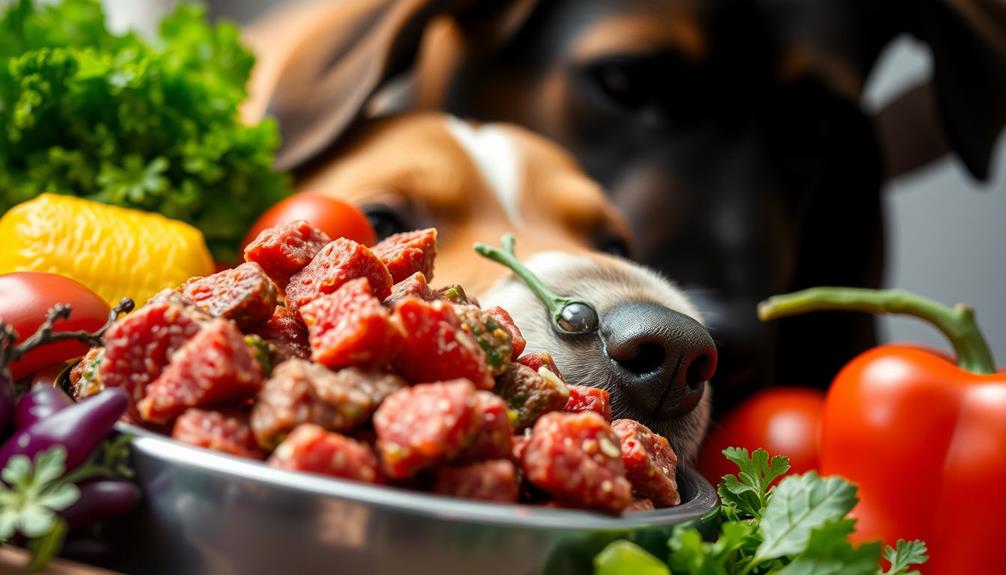
Food additives in commercial dog diets can greatly impact your pet's health, potentially leading to serious issues like seizures. Many processed dog foods contain these additives, which can have harmful effects on your dog's neurological well-being.
For instance, certain artificial colors, like Red Dye 40, are linked to seizures, highlighting the risks of synthetic ingredients. Additionally, just as with heat pumps that can fail due to poor quality components or inadequate maintenance, the presence of harmful additives can compromise your dog's health and well-being best heat pump options.
Consider the following food additives that could affect your dog's health:
- BHA and BHT: These preservatives may contribute to cancer development over time, affecting overall health and increasing seizure risk.
- Glutamate: Commonly used as a flavor enhancer, high levels can stimulate abnormal brain activity, potentially triggering seizures in susceptible dogs.
- Chemical additives: Long-term exposure can lead to increased seizure frequency, making careful ingredient selection essential.
Being vigilant about what you feed your dog is important. Avoiding processed foods filled with unnatural substances can help reduce the potential for seizure triggers.
Other Environmental Triggers

When it comes to seizures in dogs, environmental triggers can really set things off. It's vital to be aware of your dog's surroundings and the potential hazards. Toxic substances like certain house plants, cleaning products, and even food can induce seizures. High levels of chemicals in the yard, such as pesticides and fertilizers, can also be a problem. Consider using natural alternatives instead.
Here's a quick overview of common environmental triggers:
| Trigger Type | Details |
|---|---|
| Household Products | Cleaning agents and certain plants |
| Outdoor Chemicals | Pesticides and fertilizers |
| Food Ingestion | Caffeine, dark chocolate, and high-glutamate foods |
| Stress Factors | Loud noises and changes in routine |
Keeping these factors in mind helps you create a safer environment for your furry friend. Additionally, it's important to minimize stressful situations that might exacerbate your dog's condition. By staying vigilant and informed about these environmental triggers, you can help reduce the risk of seizures and promote your dog's well-being.
Recommended Foods for Dogs
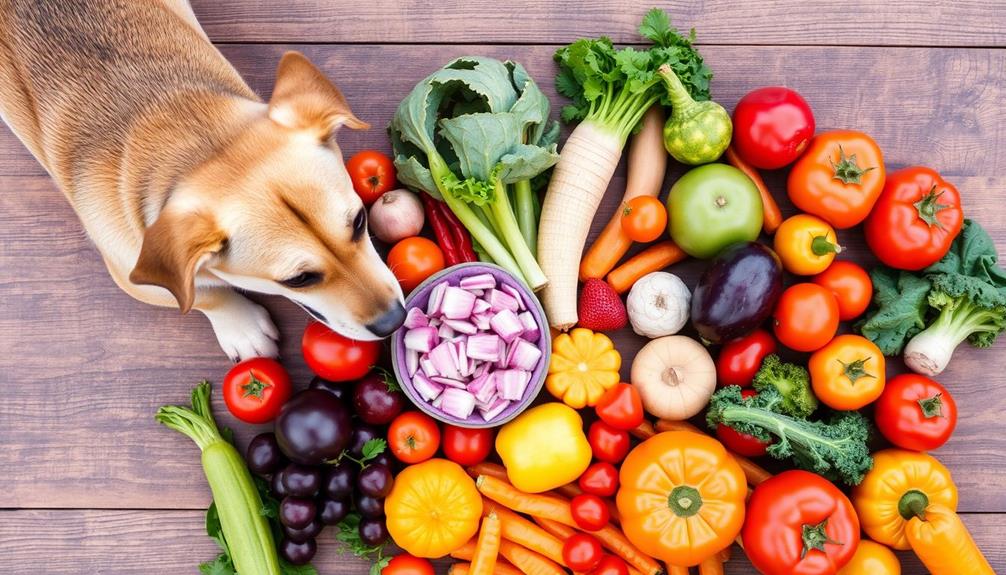
Many dog owners frequently explore the benefits of raw diets for their pets, especially when managing health issues like seizures. Choosing the right recommended foods can make a significant difference in supporting your dog's brain health and overall well-being.
High-quality proteins, like raw meats and fish, are essential as they provide amino acids and omega-3 fatty acids that may help reduce inflammation linked to seizures.
Consider incorporating the following foods into your dog's raw diet:
- DHA-rich foods: Eggs are excellent for promoting cognitive function and may help lessen seizure frequency.
- Low-glutamate fruits and vegetables: Fresh options like kale and berries offer antioxidants and vitamins that protect brain tissue cells from oxidative stress.
- Gelatin from grass-fed animals: This adds glycine to meals, which could help protect against seizure-related brain damage.
Avoid high-glutamate ingredients such as grains and dairy, as they may exacerbate seizure tendencies in susceptible dogs.
Consulting Your Veterinarian
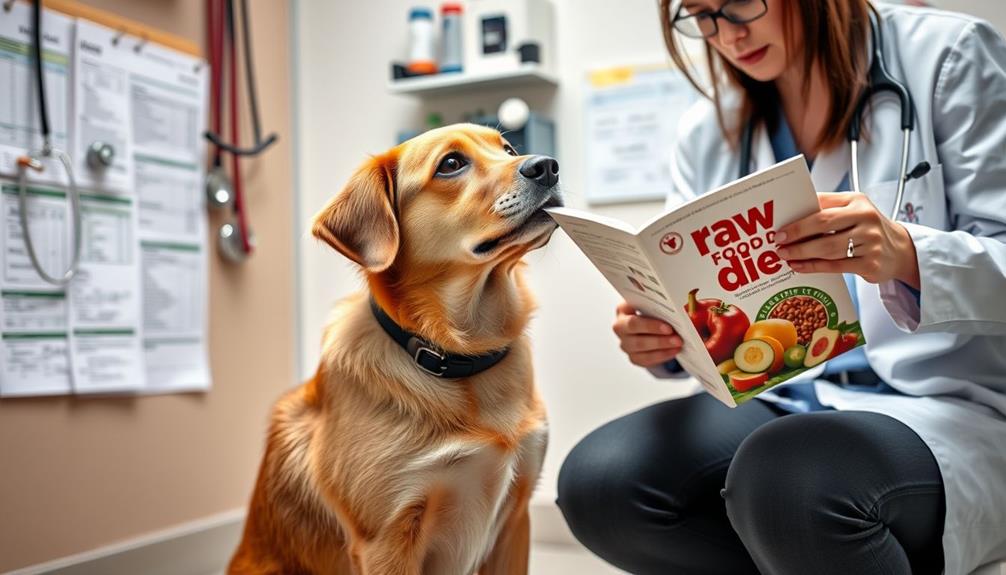
Before making significant changes to your dog's diet, it's essential to consult your veterinarian. This step is especially important if your dog has a history of seizures. Your veterinarian can help identify any specific dietary triggers that may exacerbate seizure activity. For instance, high-glutamate foods often found in raw diets could potentially worsen your dog's condition.
Regular veterinary consultations guarantee that your dog's nutritional needs are being met while minimizing the risk of introducing potential seizure-inducing ingredients. They can guide you on safe raw food practices, helping to prevent contamination and guaranteeing balanced nutrition, which is fundamental for dogs prone to seizures.
Monitoring your dog's response to dietary changes under veterinary supervision is critical. This allows you to assess the effectiveness of the new diet in managing seizure frequency and severity.
Your veterinarian can also provide tailored recommendations based on your dog's unique health profile, guaranteeing you make informed decisions about their diet. By prioritizing consultations, you're taking a proactive approach in safeguarding your dog's health while exploring the raw food diet.
Frequently Asked Questions
What Ingredients in Dog Food Can Cause Seizures?
Certain ingredients in dog food, like high-glutamate foods, artificial additives, and excessive fats, can increase seizure risks. You should avoid processed options and carefully read labels to prevent potential neurotoxic effects on your dog.
Is a Raw Diet Good for Dogs With Seizures?
A raw diet can potentially benefit dogs with seizures by providing crucial nutrients and omega-3 fatty acids. However, it's important to consult your vet to guarantee the diet is balanced and safe for your dog.
Does Anything Trigger Seizures in Dogs?
Have you ever wondered what could set off a seizure in your dog? Environmental toxins, certain foods, medications, and even genetic factors can trigger these episodes, so staying informed about potential hazards is essential for your pet's health.
What Is the Best Diet for a Dog With Seizures?
To manage your dog's seizures, focus on a diet rich in omega-3 fatty acids, high-quality fats, and fresh, natural ingredients. Avoid high-glutamate foods and consider incorporating herbs to support overall brain health and well-being.
Conclusion
In the grand tapestry of your dog's health, every thread matters. While raw food can offer benefits, it is crucial to be mindful of potential risks, like nutritional imbalances and harmful ingredients that could spark seizures. Just as a master painter carefully selects colors, you should choose your dog's diet wisely. Always consult your veterinarian to create a vibrant and balanced menu that supports your furry friend's well-being. After all, a healthy pup is the masterpiece we all desire.



